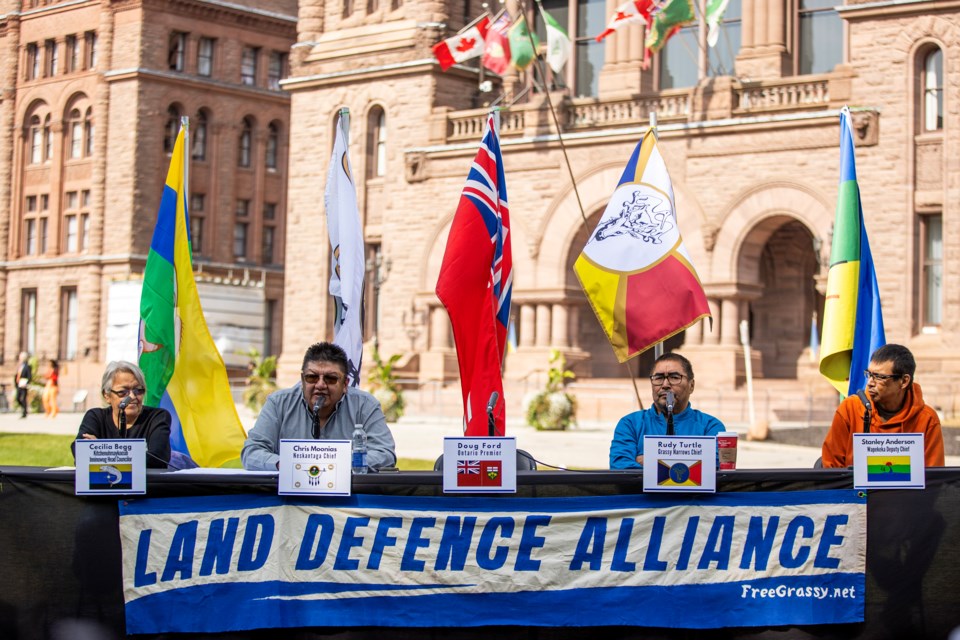Editor's note: This article originally appeared on The Trillium, a Village Media website devoted exclusively to covering provincial politics at Queen’s Park.
Indigenous leaders from the Land Defence Alliance came to Queen's Park on Tuesday to keep pressuring the premier to meet with them on the government's mining policies — including the marquee Ring of Fire project — after rejecting a meeting with Indigenous Affairs and Northern Development Minister Greg Rickford.
The Alliance is made up of five First Nations communities — Neskantaga, Muskrat Dam First Nations, Wapekeka, Asubpeeschoseewagong Anishinabek (Grassy Narrows), and Kitchenuhmaykoosib Inninuwug (Big Trout Lake).
The Nations are in varying degrees of opposition to mining and other forms of resource development. Some are totally opposed, while others are looking for better consultation processes, they said.
The group wrote to Ford last week but the premier "tried to pass the buck" — according to a press release — and offered a meeting with Rickford instead.
"We don't want to meet with Rickford. We want to meet with Ford," said Grassy Narrows Chief Rudy Turtle. "Ford sets the policies for his government. He's the one that's been saying he wants to proceed with the Ring of Fire and other mining activities."
The Sept. 20 letter asked Ford to meet with the Alliance on the lawn of Queen's Park to sign a declaration that would "respect our Nations' right to say no to mining."
Rickford wrote back saying he "would be pleased" to meet with the Alliance on Sept. 26 after question period.
Rickford, however, didn't sign the pledge and explained why to reporters.
"This isn't about the premier not meeting," he said in a media scrum. "Today's opportunity reflects a set of circumstances that I just don't believe are productive."
"There's a difference between asking for a good meeting versus a table set outside with a document that asks the premier and myself to discontinue developing northern Ontario, that's at cross purposes with the communities surrounding them," he added.
Rickford brought up the Webequie and Marten Falls First Nations that have partnered with the government on moving the Ring of Fire forward as an example of finding common ground between competing interests.
Webequie First Nation sits just west of the Ring of Fire area. The government wants to build a supply road from the Nation to the Ring of Fire and the two parties are working on an environmental assessment of the road.
Marten Falls is hundreds of kilometres south of the Ring of Fire. It's working with the government on an environmental assessment for a road that would connect the Nation to the existing provincial highway network.
Both Webequie and Marten Falls are teaming up with the government for a road that would connect the Webequie road to the Ring of Fire, which would create a full road network from the existing highway near Aroland First Nation in the south, through Marten Falls, up to Webequie and the Ring of Fire in the north.
"These are communities who see this as a progressive opportunity to create a new path forward to prosperity, improve the infrastructure in their communities, and ensure that their young people have opportunities in every aspect of northern development. That's what my role and responsibility is," Rickford said.
Getting the roads built to the remote region is a key first step in developing the integrated supply chain to bolster Ontario's electric vehicle manufacturing ambitions. The Ring of Fire has many minerals that go into EV manufacturing but the resources can't be tapped without significantly expanding existing infrastructure.
Neskantaga Chief Chris Moonias, whose territory sits along the Attiwapiskat River, which the road to the Ring of Fire would cross, said he's open to development and industry so long as his people are consulted on their terms.
Other leaders, like Chief Turtle from Grassy Narrows, want to stop all mining and other forms of resource extraction on his territory.
"We are here to say no to any kind of industrial development," he said. "We know from firsthand experience what industrial activity does to our people. It poisons our people."
Turtle referred to the ongoing mercury poisoning crisis that's plagued the community for generations after a chemical plant dumped the toxin into the English-Wabigoon river system in the late 1960s.
In July, a peer-reviewed study linked high levels of mercury exposure to elevated suicide rates in Grassy Narrows.
While the group members have slightly different end goals — stopping mining outright versus wanting better consultation on the Ring of Fire — they're still united in opposition.
Turtle said if it comes to putting bodies in the way of bulldozers, the group is ready.
"First of all, we're just going to keep saying no. If we have to stand up physically or take some physical action to do that, we're going to be blockading and they'll have to meet us face to face if it comes to that. That's not our preference," he said.
If Neskantaga and the government can't agree on how to solve the Ring of Fire impasse, the other four Nations will lend a hand, Turtle said.
"If Neskantaga needs help, we're going to send our people to stand with them."
It's not the first time the group or members of individual Nations have flown to Toronto to voice displeasure with the government and secure a meeting with Ford.
The Alliance held a protest outside the Ministry of Mines in Toronto on July 20 after
Chris Moonias and former Neskantaga chief Wayne Moonias were escorted out of Queen's Park this spring after disrupting question period by demanding a meeting with Ford.
